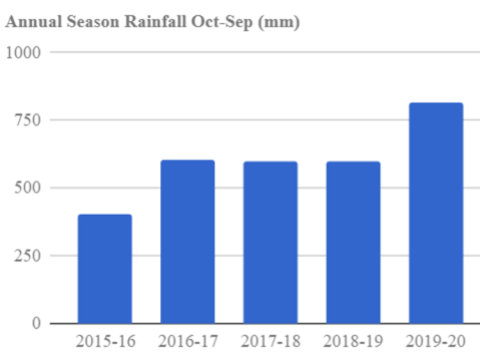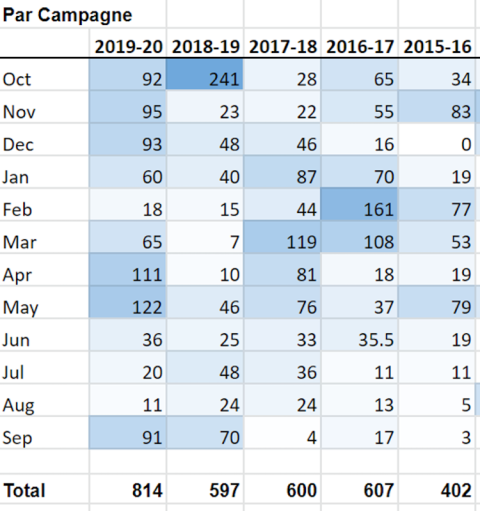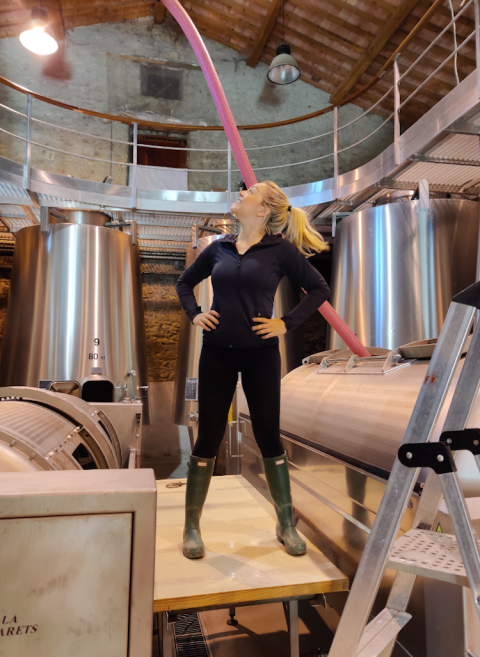While the global pandemic pursues its inexorable advance, its effects on the wine industry will be felt for many years to come. Combined with oversupply and stubbornly high stock levels in 2018 and 2019, some regions have been forced to artificially curtail yields to try to balance supply and demand, and, more poignantly, many wine producers, their tanks and barrels still full of unsold wine, struggled to find empty containers for the incoming 2020 grapes. The 2020 harvest is looking plentiful, precocious and healthy in most parts, though 2021 is still clouded in uncertainty for the final product and the livelihoods of all those involved.
Against that challenging backdrop, the Minervois harvest looks to be a very good one, at least for those who managed to get through the wet start to the season without disease, and to bring in their grapes before the rains came in mid September.
We concluded last year with plentiful wine tanks, but with the worry that water tables were not replenished after a warm and dry spring and summer in 2019. Even though rainfall through the September 2018 to August 2019 period has been remarkably consistent at about 600 mm of rain over three years, the April to August 2019 part of that was dry relative to other years.
The rain gods smiled on us this season, especially in the winter/spring of 2019/20. The last months of 2019 saw almost 100 mm of rain per month, and, in particular, April and May 2020 notched up 233 mm of rain (versus 56 mm in same period in 2019). However, be careful what you wish for! Suddenly, tractors couldn't get out and things looked dire. With rising temperatures, budding accelerated and a serious onset of fungal diseases threatened under a combination of warmth and moisture. Earlier smiles on our faces turned to consternation at the prospect of waves of mildew.
Arnaud, our resident oenologist (on the left of the picture above), had only to sniff a whiff of potential mildew and he was out in the fields, working to keep the fungus at bay within the limits of organic practices – and he was largely successful. With mildew, one cannot wait until Monday morning and take the weekend off. If you do, the fungus can be carried in the wind and/or splashed back on to the vines and install itself. It's a formula for disaster, as it spreads so quickly. Several mornings I was woken early by the sound of his tractor (as soon as the soil became hard enough), but sunk back under the covers, reassured by his efforts. In addition, careful canopy management in recent years has been successful in reducing leaf-bunching, which can exacerbate the risk.
Consequently, we escaped the worst of any damage to the vines during this fragile period, when vines are most susceptible to permanent damage and loss of fruit, especially Grenache if it suffers from coulure. Once the budding translated into fruit, worries partly went away but not entirely, as the period of flowering and fruit set is always a delicate one, with the latter being quite short. We were watching the weather forecasts with concern towards the end of May as temperatures dropped. Frost at this delicate time can also be disastrous, the danger from which does not disappear until the end of May. Temperatures did drop, but not to freezing, the breezes up the central part of the property keeping Jack Frost away.
To be honest, autumn of 2019 and the first five months of 2020 were difficult to work, whether the manual pruning or tractor work. The outlook was worrying and essential work was delayed. Prayers were uttered for a return to more normal weather patterns.
Having exited May with no damage, sighs of relief were now audible and we relished the possibility of a good harvest under blue skies and above-average temperatures. With the firming of the bunches into June, the risk of disease weakens. Hail would become the next potential concern but storm activity was remote during June and July, and passed nearby in early September.
The move into the ripening phase continued, with both fattening and colouring (veraison) progressing without much concern and indications were also for an early harvest. The weather unfolded into an uninterruptedly warm, dry summer laying the foundation for quality. The earlier rains in April and May, while disruptive to work at the time, had a silver lining and replenished the water table, allowing vines to surmount the dry summer months without any unwanted hydric stress. But they also gave free rein to growth of weeds, requiring numerous passages of our faithful intercept (mechanical weeding machine), chemical control being highly regulated under our organic protocol.
Août fait le moût (August makes the must), goes the saying. It’s usually a relatively quiet month for winemakers, apart from some weeding and trimming of the vines to ensure that excessive growth isn’t caught up by tractors and/or harvesting machines, causing damage to the plants. The analysis of progress in mid-August showed:
- maturation was one week in advance of average, with white varieties up to two weeks ahead of 2019
- a steady acceleration in maturation, but under conditions of warm days and cool nights
- healthy fruit across the board and no water stress
- higher acidity than 2019
- overall lower potential alcohol than 2019.
The end of August was blessed with 10 mm of rain, enough to moisten the soil and steady the maturation but not so much as to bloat the grapes and risk diseases that can ensue if the grapes burst. Maturation of both the Syrah and Grenache, our predominant red-wine grapes, stabilised in September, a month of cool nights and slowly descending daytime temperatures.
Harvesting started on 20 August with the whites: Roussanne first, then the Vermentino and Viognier. Machine-picking was conducted very early in the mornings, from 4 am while the grapes were still cool, to prevent premature oxidation during transport. The Vermentino has proven to be a pillar of our whites, adjusting well to the hot, dry conditions of summer 2020.
Our whites yielded 35% less than in 2019, partly due to our approach to reworking the canopy and pruning, but they manifested fruitiness, pronounced aromas and higher acidity. We've increased our use of barrels for fermentation and ageing for some of our whites again this year. With 10 varieties allowed for AOP Minervois and up to 32 for IGP Pays d’Oc, whites are generating increasing interest as an excellent value-for-money proposition in our region. Expect to see more variety in our whites in coming years.
The whites were followed by the Grenache for our rosé, picked early in the morning too, followed by the Mourvèdre. Pressed upon arrival, the fruit juice was cooled further to accelerate the deposit of any solids before fermentation. Both whites and rosé are fermented at 15–20 °C, cooler than for the reds but which better maintains acidity and fruitiness. It takes longer to complete but the wait is worth it in favourable years!
Grenache for the reds was followed 10 days later by the Syrah, our most important variety, on 14 September. The 2019 Syrah suffered from some wilting for lack of water. But not in 2020 when the grapes were healthy and firm with no bitterness. We were blessed with high quality all round, notably our older vines with deeper roots. The 2020 Grenache for the reds, largely from a single 2.5-ha (6.2-acre) vineyard, yielded more than in 2019, accompanied by a concentration of maturity and fruitiness that was better than expected.
Finally, the Carignan (only 4–5% of our production now, versus some 80% when I arrived in 2001) displayed a balance of fruitiness and acidity, with firmness of feel.
We finished the harvest on 23 September, just a day before the rains reappeared along with distinctly cooler weather. Shorts went back in the drawers! Arnaud our oenologist summarises 2020 as ‘a year of fruity wines, with good structure and a zippy freshness to them. Wines that can be drunk soon after bottling but will mature well.’ All our consternation back in April and May was replaced in August and September with recognition that full water tables and warm, dry weather would produce a good-quality harvest. So, thank you Mother Nature!

















